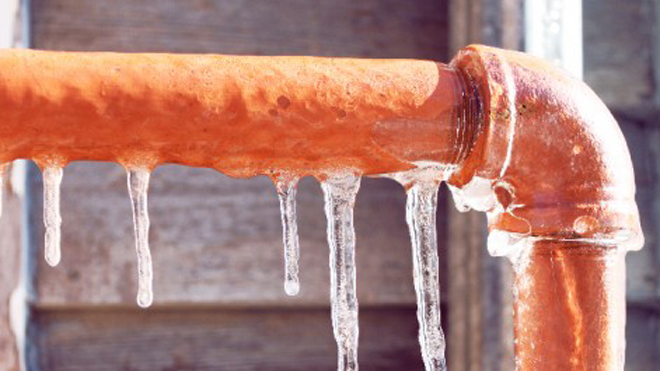Avoiding Pipes from Cold Weather: Effective Methods
Avoiding Pipes from Cold Weather: Effective Methods
Blog Article
The article down the page pertaining to How to Prevent Your Pipes From Freezing is fairly fascinating. Read it for yourself and decide what you think about it.
:strip_icc()/snow-outdoor-faucet-pipes-4af65d1e5e904fb1aa7bf74071fe5d89.jpg)
Cold weather can damage your plumbing, specifically by freezing pipelines. Right here's how to prevent it from occurring and what to do if it does.
Intro
As temperature levels drop, the risk of frozen pipelines boosts, possibly bring about expensive fixings and water damage. Recognizing exactly how to stop icy pipelines is important for home owners in cold climates.
Avoidance Tips
Insulating prone pipelines
Wrap pipes in insulation sleeves or utilize warm tape to secure them from freezing temperatures. Concentrate on pipelines in unheated or exterior areas of the home.
Home heating techniques
Keep indoor spaces adequately warmed, particularly locations with plumbing. Open cupboard doors to enable cozy air to flow around pipes under sinks.
Exactly how to recognize frozen pipelines
Search for lowered water flow from faucets, uncommon smells or noises from pipelines, and visible frost on exposed pipes.
Long-Term Solutions
Architectural changes
Think about rerouting pipelines away from outside wall surfaces or unheated areas. Include added insulation to attics, basements, and crawl spaces.
Upgrading insulation
Purchase top quality insulation for pipelines, attic rooms, and wall surfaces. Appropriate insulation assists keep constant temperature levels and decreases the risk of frozen pipelines.
Protecting Exterior Pipes
Garden hoses and exterior faucets
Separate and drain yard hoses prior to wintertime. Set up frost-proof spigots or cover outdoor faucets with protected caps.
Comprehending Icy Pipes
What creates pipelines to freeze?
Pipes ice up when exposed to temperature levels listed below 32 ° F (0 ° C) for prolonged periods. As water inside the pipes ices up, it increases, taxing the pipeline walls and potentially triggering them to rupture.
Risks and damages
Icy pipelines can bring about water disturbances, home damage, and pricey repair work. Ruptured pipes can flooding homes and trigger substantial structural damage.
Indicators of Frozen Piping
Determining icy pipes early can avoid them from breaking.
What to Do If Your Pipes Freeze
Immediate actions to take
If you believe frozen pipelines, keep taps open to alleviate pressure as the ice melts. Use a hairdryer or towels taken in hot water to thaw pipelines gradually.
Verdict
Stopping icy pipes needs aggressive steps and fast feedbacks. By recognizing the reasons, signs, and preventive measures, house owners can protect their plumbing during winter.
5 Ways to Prevent Frozen Pipes
Drain Outdoor Faucets and Disconnect Hoses
First, close the shut-off valve that controls the flow of water in the pipe to your outdoor faucet. Then, head outside to disconnect and drain your hose and open the outdoor faucet to allow the water to completely drain out of the line. Turn off the faucet when done. Finally, head back to the shut-off valve and drain the remaining water inside the pipe into a bucket or container. Additionally, if you have a home irrigation system, you should consider hiring an expert to clear the system of water each year.
Insulate Pipes
One of the best and most cost-effective methods for preventing frozen water pipes is to wrap your pipes with insulation. This is especially important for areas in your home that aren’t exposed to heat, such as an attic. We suggest using foam sleeves, which can typically be found at your local hardware store.
Keep Heat Running at 65
Your pipes are located inside your walls, and the temperature there is much colder than the rest of the house. To prevent your pipes from freezing, The Insurance Information Institute suggests that you keep your home heated to at least 65 degrees, even when traveling. You may want to invest in smart devices that can keep an eye on the temperature in your home while you’re away.
Leave Water Dripping
Moving water — even a small trickle — can prevent ice from forming inside your pipes. When freezing temps are imminent, start a drip of water from all faucets that serve exposed pipes. Leaving a few faucets running will also help relieve pressure inside the pipes and help prevent a rupture if the water inside freezes.
Open Cupboard Doors
Warm your kitchen and bathroom pipes by opening cupboards and vanities. You should also leave your interior doors ajar to help warm air circulate evenly throughout your home.

Do you appreciate reading about Preventing and dealing with frozen pipes? Post a short review down below. We would be delighted to see your thinking about this article. We hope to see you back again later on. Sharing is caring. You never know, you will be helping someone out. Thanks a lot for your time. Revisit us soon.
Browse Website Report this page